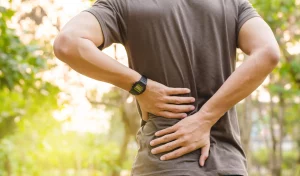Exploring the Depths of Back Pain: A Comprehensive Guide
 Back pain therapy, serves as a crucial resource for individuals grappling with the persistent discomfort of back pain. This specialized therapy aims to address various types of back pain, providing targeted interventions to alleviate symptoms and enhance overall spine health. Let’s explore the introduction section, tailored specifically for individuals seeking Back Pain Therapy in Clearwater, FL:
Back pain therapy, serves as a crucial resource for individuals grappling with the persistent discomfort of back pain. This specialized therapy aims to address various types of back pain, providing targeted interventions to alleviate symptoms and enhance overall spine health. Let’s explore the introduction section, tailored specifically for individuals seeking Back Pain Therapy in Clearwater, FL:
Introduction
Back pain can be a debilitating issue, affecting your daily life and overall well-being. If you’re in Clearwater, FL, and grappling with persistent back pain, understanding the nuances of this discomfort is the first step toward effective management. This comprehensive guide is designed to shed light on the diverse types of back pain and introduce you to the world of specialized back pain therapy available in Clearwater.
A. Overview of Back Pain
Back pain isn’t a one-size-fits-all experience. It can stem from various sources, including muscle strains, spinal issues, and lifestyle factors. Recognizing the specific nature of your back pain is crucial for tailoring an effective therapeutic approach.
B. Significance of Understanding Types of Back Pain
In the realm of back pain therapy in Clearwater, recognizing the significance of understanding different types of back pain is paramount. It empowers both you and your therapist to develop a personalized treatment plan that addresses the root cause of your discomfort.
C. Importance of Early Recognition
When seeking back pain therapy in Clearwater, early recognition of your specific back pain type is instrumental in achieving optimal outcomes. Timely intervention can prevent the exacerbation of symptoms and contribute to a quicker and more sustained recovery.
Embark on a journey to explore the depths of back pain, unraveling its various types and paving the way for effective back pain therapy in Clearwater, FL. Whether you’re dealing with muscle-related strains, spinal issues, or lifestyle-induced discomfort, this guide is your compass to navigate the path toward a healthier, pain-free back.
Anatomy of the Spine
Understanding the intricacies of the spine is fundamental to grasping the various types of back pain. Let’s delve into this section to gain insights into the structure, functions, and the role of nerves in the spine.
A. Brief Overview of Spinal Structure
The spine, also known as the vertebral column, is a remarkable structure that provides support, flexibility, and protection for the spinal cord. Comprising 33 vertebrae, it can be divided into five regions: cervical, thoracic, lumbar, sacral, and coccygeal. Each vertebra is separated by intervertebral discs, acting as shock absorbers and facilitating movement.
B. Functions of Different Spinal Components
To comprehend back pain, it’s crucial to understand the roles of various spinal components. The cervical spine supports the head and allows neck movement, while the thoracic spine provides stability and protects vital organs. The lumbar spine, bearing the most weight, facilitates bending and twisting motions. The sacral and coccygeal regions contribute to pelvic support and stability.
C. The Role of Nerves in Back Pain
The spine serves as a conduit for nerves transmitting signals between the brain and the rest of the body. When nerves are affected, it can lead to various types of back pain. For instance, compression of spinal nerves can result in shooting pain or numbness. Understanding this nerve-spine connection is pivotal in identifying the root causes of specific back pain conditions.
Back pain is a prevalent issue, and understanding the differences between acute and chronic back pain is crucial for effective management and tailored treatment plans.
A. Distinguishing Characteristics
Acute Back Pain:
Acute back pain typically manifests suddenly and is often caused by injury or trauma. It lasts for a short duration, ranging from a few days to a few weeks. The pain is usually sharp and intense, and its onset is linked to specific incidents like lifting heavy objects, sudden movements, or accidents.
Chronic Back Pain:
Chronic back pain, on the other hand, persists for an extended period, typically exceeding three months. It can stem from an initial injury or develop gradually over time. The pain may be more persistent, and individuals with chronic back pain often experience periods of exacerbation and relief.
B. Short-term and Long-term Implications
Acute Back Pain:
While acute back pain can be intense, it often comes with a positive prognosis. In many cases, it resolves with appropriate rest, pain management, and sometimes physical therapy. The short-term implications are usually limited, and individuals can often return to their normal activities once the acute episode subsides.
Chronic Back Pain:
Chronic back pain, being persistent, can have more profound implications. It may significantly impact daily life, limiting mobility and affecting emotional well-being. Individuals with chronic back pain may experience challenges in work, relationships, and overall quality of life. Managing chronic back pain requires a more comprehensive and long-term approach.
C. Treatment Approaches for Each
Acute Back Pain:
Treatment for acute back pain often involves short-term measures such as rest, over-the-counter pain medications, and applying ice or heat. Physical therapy may be beneficial to aid in the recovery process. The focus is on alleviating symptoms and preventing the acute issue from developing into a chronic condition.
Chronic Back Pain:
Managing chronic back pain requires a more multifaceted approach. It may involve a combination of physical therapy, medications, lifestyle modifications, and psychological support. In some cases, interventions like surgery might be considered. The goal is not just to alleviate symptoms but also to improve overall function and quality of life.
Understanding the distinctions between acute and chronic back pain is essential for individuals and healthcare professionals alike. While acute pain may resolve with relatively simple interventions, chronic pain necessitates a more comprehensive and ongoing strategy to enhance long-term well-being.
Age-related Back Pain
As we journey through life, our bodies undergo natural changes, and the spine is no exception. Age-related back pain encompasses a spectrum of issues that become more prevalent as we grow older. Understanding these challenges is crucial for proactively managing and maintaining back health in the later stages of life.
A. Common Back Issues in Different Age Groups
Age introduces unique factors that contribute to back pain. In this section, we explore the distinct challenges faced by individuals in various age brackets.
- Childhood and Adolescence:
- Spinal abnormalities and conditions that may emerge during growth phases.
- The importance of promoting proper posture and spine health in early years.
- Adulthood (30s-50s):
- Increasing susceptibility to disc degeneration and wear-and-tear injuries.
- Lifestyle factors contributing to back pain, such as sedentary jobs and insufficient exercise.
- Later Years (50s and beyond):
- Higher prevalence of conditions like osteoarthritis and spinal stenosis.
- The impact of aging on intervertebral discs and joint function.
B. Aging and Degenerative Changes
The aging process inevitably brings about changes in the spine’s structure and function. Understanding these degenerative changes provides insights into the origins of age-related back pain.
- Disc Degeneration:
- Explanation of how intervertebral discs lose water content and flexibility over time.
- The role of diminished disc height in contributing to discomfort.
- Osteoarthritis:
- Exploration of how wear-and-tear on joints can lead to arthritis-related back pain.
- The impact of cartilage breakdown and bony overgrowths on spinal health.
- Loss of Bone Density:
- Explanation of how aging can result in decreased bone density, potentially leading to fractures and vertebral compression.
C. Maintaining Back Health in Later Years
While age-related changes are inevitable, there are proactive measures individuals can take to preserve back health and mitigate the impact of aging on the spine.
- Regular Exercise and Strength Training:
- Emphasis on the importance of low-impact exercises to maintain muscle tone and flexibility.
- Specific exercises targeting the core and back muscles to provide support.
- Healthy Nutrition and Weight Management:
- The role of a balanced diet in supporting bone health.
- Weight management strategies to reduce strain on the spine.
- Posture Awareness:
- Tips for maintaining good posture in daily activities to alleviate unnecessary stress on the spine.
- Ergonomic considerations for workspaces and furniture.
- Regular Check-ups and Early Intervention:
- Encouragement for routine medical check-ups to identify and address emerging back issues promptly.
- The significance of early intervention in managing age-related back pain effectively.
In navigating age-related back pain, adopting a proactive and holistic approach is key. By understanding the specific challenges associated with different life stages, individuals can empower themselves to take charge of their spinal health and enjoy a more comfortable and active life as they age.
Diagnosis of Back Pain
Understanding the root cause of back pain is crucial for developing an effective treatment plan. The diagnostic process involves a comprehensive approach, encompassing medical history assessment, various imaging techniques, and collaboration with healthcare professionals.
A. Medical History Assessment
Gathering a thorough medical history is the initial step in diagnosing back pain. Healthcare professionals inquire about the onset of symptoms, the nature of pain, factors that alleviate or worsen it, and any relevant medical conditions. This holistic approach helps in identifying patterns, potential triggers, and underlying health issues contributing to back pain.
B. Imaging and Diagnostic Tests
To pinpoint the source of back pain, medical imaging plays a vital role. Different tests provide valuable insights into the spine’s structure and potential abnormalities:
- X-rays: Useful for detecting bone abnormalities, fractures, or degenerative changes.
- MRI (Magnetic Resonance Imaging): Offers detailed images of soft tissues, discs, and nerves, aiding in the diagnosis of conditions like herniated discs.
- CT (Computed Tomography) Scan: Provides detailed cross-sectional images, beneficial for identifying bone and joint-related issues.
- Bone Scans: Helpful in detecting fractures, infections, or tumors affecting the bones.
C. Role of Healthcare Professionals
Collaboration with healthcare professionals is integral to accurate diagnosis and effective treatment. Various specialists may be involved, depending on the nature of the back pain:
- Primary Care Physician: Conducts initial assessments and may refer to specialists.
- Orthopedic Specialist: Specializes in musculoskeletal issues, offering expertise in bone and joint-related conditions.
- Neurologist: Focuses on nerve-related disorders, crucial for cases involving nerve compression or damage.
- Rheumatologist: Specializes in autoimmune and inflammatory conditions that may contribute to back pain.
The coordinated effort of these professionals ensures a comprehensive understanding of the back pain’s origin, leading to a tailored and effective treatment plan. Timely and accurate diagnosis significantly improves the chances of successful intervention and recovery.
Non-surgical Treatments
Non-surgical treatments are crucial components in the comprehensive approach to managing back pain. These alternatives focus on relieving pain, improving functionality, and enhancing overall well-being without resorting to invasive procedures.
A. Physical Therapy
1. Tailored Exercise Programs
- Physical therapists design customized exercise routines targeting specific muscle groups to alleviate pain and strengthen the core.
2. Manual Therapy Techniques
- Hands-on techniques, such as massage and joint mobilization, are employed to reduce muscle tension and improve flexibility.
3. Rehabilitation and Posture Correction
- Rehabilitation programs aim to restore functionality, while posture correction techniques address improper alignment contributing to back pain.
B. Medications for Pain Management
1. Analgesics
- Over-the-counter pain relievers like acetaminophen or prescription medications such as opioids may be prescribed to manage pain.
2. Anti-inflammatory Drugs
- Nonsteroidal anti-inflammatory drugs (NSAIDs) help reduce inflammation, providing relief from conditions like arthritis-related back pain.
3. Muscle Relaxants
- Medications to alleviate muscle spasms and promote relaxation, particularly beneficial for muscle-related back pain.
C. Alternative Therapies
1. Chiropractic Care
- Chiropractors use manual adjustments to realign the spine, providing relief from conditions like herniated discs and misalignments.
2. Acupuncture
- Traditional Chinese medicine involves inserting thin needles into specific points to stimulate energy flow, offering relief from pain and promoting healing.
3. Massage Therapy
- Therapeutic massage helps relax muscles, reduce tension, and improve blood circulation, contributing to pain relief.
Non-surgical treatments offer a range of options, allowing individuals to choose the approach that aligns best with their preferences and the nature of their back pain. These interventions not only address symptoms but also contribute to long-term spine health and improved quality of life.
Conclusion
In conclusion, exploring the diverse facets of back pain provides invaluable insights into its origins, management, and prevention. From understanding the intricate anatomy of the spine to delving into specific types of back pain and their respective treatments, this comprehensive guide serves as a roadmap for individuals seeking relief. Whether it’s adopting preventive measures, embracing non-surgical treatments like physical therapy and alternative therapies, or considering surgical interventions when necessary, the key lies in informed decision-making. For those in Clearwater, FL, searching for effective back pain therapy, the wealth of knowledge shared here serves as a foundation. Seeking professional guidance from healthcare experts in Back Pain Therapy Clearwater, FL, can further tailor these insights to individual needs, fostering a path towards a healthier, pain-free life.
Frequently Asked Questions
Q1: What are the most common causes of back pain?
Ans: Back pain can result from various factors, including muscle strains, herniated discs, arthritis-related issues, spinal stenosis, and scoliosis. Understanding these causes is crucial for effective management.
Q2: What are non-surgical treatments, and how effective are they?
Ans: Non-surgical treatments encompass physical therapy, medications, and alternative therapies. These approaches are highly effective in managing back pain, providing relief, and improving overall functionality.
Q3: Where can I find Back Pain Therapy in Clearwater, FL?
Ans: For residents in Clearwater, FL, seeking specialized back pain therapy, consulting with healthcare experts in the area, and exploring local clinics offering Back Pain Therapy services is recommended for tailored solutions. You can conatct us on this Number – (727) 785-8737

 Previous Post
Previous Post
